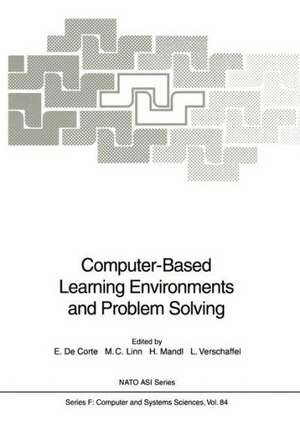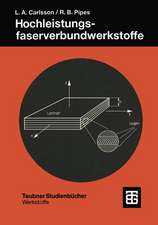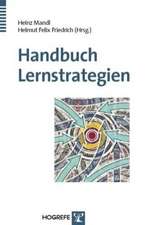Computer-Based Learning Environments and Problem Solving: NATO ASI Subseries F:, cartea 84
Editat de Erik De Corte, Marcia C. Linn, Heinz Mandl, Lieven Verschaffelen Limba Engleză Paperback – 21 dec 2011
Din seria NATO ASI Subseries F:
- 20%
 Preț: 650.27 lei
Preț: 650.27 lei - 20%
 Preț: 668.55 lei
Preț: 668.55 lei - 20%
 Preț: 992.44 lei
Preț: 992.44 lei - 18%
 Preț: 1239.19 lei
Preț: 1239.19 lei - 20%
 Preț: 1922.81 lei
Preț: 1922.81 lei - 20%
 Preț: 654.37 lei
Preț: 654.37 lei - 18%
 Preț: 1234.00 lei
Preț: 1234.00 lei - 20%
 Preț: 709.78 lei
Preț: 709.78 lei - 20%
 Preț: 656.03 lei
Preț: 656.03 lei - 18%
 Preț: 1854.94 lei
Preț: 1854.94 lei - 20%
 Preț: 374.97 lei
Preț: 374.97 lei - 20%
 Preț: 991.94 lei
Preț: 991.94 lei - 20%
 Preț: 671.02 lei
Preț: 671.02 lei - 20%
 Preț: 1925.96 lei
Preț: 1925.96 lei - 20%
 Preț: 994.73 lei
Preț: 994.73 lei -
 Preț: 389.49 lei
Preț: 389.49 lei - 20%
 Preț: 657.99 lei
Preț: 657.99 lei - 20%
 Preț: 655.20 lei
Preț: 655.20 lei - 18%
 Preț: 1225.31 lei
Preț: 1225.31 lei - 18%
 Preț: 952.09 lei
Preț: 952.09 lei - 20%
 Preț: 332.06 lei
Preț: 332.06 lei - 20%
 Preț: 1284.47 lei
Preț: 1284.47 lei - 20%
 Preț: 644.81 lei
Preț: 644.81 lei -
 Preț: 395.85 lei
Preț: 395.85 lei - 18%
 Preț: 1221.07 lei
Preț: 1221.07 lei - 15%
 Preț: 643.34 lei
Preț: 643.34 lei - 20%
 Preț: 645.47 lei
Preț: 645.47 lei - 20%
 Preț: 1282.98 lei
Preț: 1282.98 lei - 20%
 Preț: 656.36 lei
Preț: 656.36 lei - 20%
 Preț: 1283.31 lei
Preț: 1283.31 lei - 20%
 Preț: 1924.15 lei
Preț: 1924.15 lei - 20%
 Preț: 362.24 lei
Preț: 362.24 lei
Preț: 654.12 lei
Preț vechi: 769.55 lei
-15% Nou
Puncte Express: 981
Preț estimativ în valută:
125.18€ • 135.93$ • 105.15£
125.18€ • 135.93$ • 105.15£
Carte tipărită la comandă
Livrare economică 22 aprilie-06 mai
Preluare comenzi: 021 569.72.76
Specificații
ISBN-13: 9783642772306
ISBN-10: 3642772307
Pagini: 508
Ilustrații: XVI, 484 p.
Dimensiuni: 170 x 242 x 27 mm
Greutate: 0.8 kg
Ediția:Softcover reprint of the original 1st ed. 1992
Editura: Springer Berlin, Heidelberg
Colecția Springer
Seria NATO ASI Subseries F:
Locul publicării:Berlin, Heidelberg, Germany
ISBN-10: 3642772307
Pagini: 508
Ilustrații: XVI, 484 p.
Dimensiuni: 170 x 242 x 27 mm
Greutate: 0.8 kg
Ediția:Softcover reprint of the original 1st ed. 1992
Editura: Springer Berlin, Heidelberg
Colecția Springer
Seria NATO ASI Subseries F:
Locul publicării:Berlin, Heidelberg, Germany
Public țintă
ResearchCuprins
I. Encouraging Knowledge Construction.- Formal education versus everyday learning.- Images of learning.- An architecture for collaborative knowledge building.- How do Lisp programmers draw on previous experience to solve novel problems?.- Analysis-based learning on multiple levels of mental domain representation.- Modeling active, hypothesis-driven learning from worked-out examples.- Fostering conceptual change: The role of computer-based environments.- Computers in a community of learners.- II. Stimulating Higher-Order Thinking and Problem Solving.- Teaching for transfer of problem-solving skills to computer programming.- Cognitive effects of learning to program in Logo: A one-year study with sixth-graders.- The role of social interaction in the development of higher-order thinking in Logo environments.- Effects with and of computers and the study of computer-based learning environments.- Facilitating domain-general problem solving: Computers, cognitive processes and instruction.- Conceptual fields, problem solving and intelligent computer tools.- III. Creating Learning Environments.- Augmenting the discourse of learning with computer-based learning environments.- Scientific reasoning across different domains.- A rule-based diagnosis system for identifying misconceptions in qualitative reasoning in the physical domain “superposition of motion”.- The provision of tutorial support for learning with computer-based simulations.- Learning and instruction with computer simulations: Learning processes involved.- Two uses of computers in science teaching: Horizontal motion simulation and simulation building.- Direct manipulation of physical concepts in a computerized exploratory laboratory.- Multimedia learning environments designed with organizing principles fromnon-school settings.













